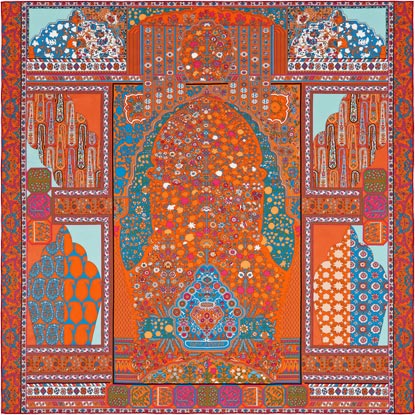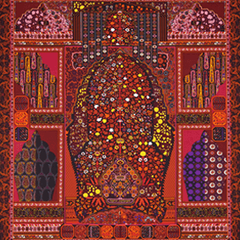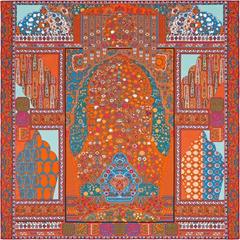Tapis Persans
Designed by Pierre Marie
First edition in 2015
Login or Register to get extra informations (rarity, sku, original prices ...)
Hermes silk twill giant plume scarf, hand-rolled, 55'' x 55''
The history of Persian carpets dates back thousands of years, beginning with the nomadic peoples of the steppes of central Asia. The knotted carpets were designed to protect them against the cold, and hung as draught-proof partitions inside their tents. The oldest surviving example – the celebrated Pazryk carpet from the Altai mountains (4th century BCE) – is an eloquent testament to its creators’ aesthetic sensibility. The secrets of carpet-making are handed down from generation to generation. Each motif is attributable to a specific, geographic place of origin. Persian rugs became enormously popular in Europe from the 13th century onwards. They were used to cover tables and chests, and as wall hangings. Some came to be named for the painters who depicted them in their work: the distinctive, so-called Lotto carpets, with their dark red ground and bold arabesque designs, are named for the artist Lorenzo Lotto (1480-1556). This carré presents a particularly fine example, inspired by a prayer rug from northern India. The Moghul empire brought Persian influences to the Indian subcontinent – in particular a refined sense of naturalism. Other decorative styles came too, reflected in the diverse motifs seen in this sumptuous, sophisticated carré. Artist Pierre-Marie has taken inspiration from rugs like these, and the superb Indian archives at the Museum of Textile Printing in Mulhouse, France.
The history of Persian carpets dates back thousands of years, beginning with the nomadic peoples of the steppes of central Asia. The knotted carpets were designed to protect them against the cold, and hung as draught-proof partitions inside their tents. The oldest surviving example – the celebrated Pazryk carpet from the Altai mountains (4th century BCE) – is an eloquent testament to its creators’ aesthetic sensibility. The secrets of carpet-making are handed down from generation to generation. Each motif is attributable to a specific, geographic place of origin. Persian rugs became enormously popular in Europe from the 13th century onwards. They were used to cover tables and chests, and as wall hangings. Some came to be named for the painters who depicted them in their work: the distinctive, so-called Lotto carpets, with their dark red ground and bold arabesque designs, are named for the artist Lorenzo Lotto (1480-1556). This carré presents a particularly fine example, inspired by a prayer rug from northern India. The Moghul empire brought Persian influences to the Indian subcontinent – in particular a refined sense of naturalism. Other decorative styles came too, reflected in the diverse motifs seen in this sumptuous, sophisticated carré. Artist Pierre-Marie has taken inspiration from rugs like these, and the superb Indian archives at the Museum of Textile Printing in Mulhouse, France.
Help us enhance Scarf Sage Hermès scarf collection by contributing additional information or higher quality images.


